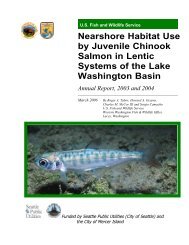2005 State of Mobility Report - City of Bellevue
2005 State of Mobility Report - City of Bellevue
2005 State of Mobility Report - City of Bellevue
Create successful ePaper yourself
Turn your PDF publications into a flip-book with our unique Google optimized e-Paper software.
High Capacity Transit (HCT)<br />
A system <strong>of</strong> transportation services, operating<br />
principally on exclusive rights-<strong>of</strong>-way, that provides<br />
substantially higher levels <strong>of</strong> passenger capacity,<br />
speed and service than conventional bus transit.<br />
(Chapters 2 and 9)<br />
High Occupancy Vehicle (HOV)<br />
A vehicle containing more than one occupant; the<br />
concept includes carpools, vanpools, and transit<br />
vehicles. In this region, cars containing at least<br />
two (three in some areas) people may use specially<br />
marked lanes on the freeways and local arterials<br />
designated for HOV-only travel. (Chapters 2 and 12)<br />
Impact Fee<br />
A fee collected from developers to proportionally<br />
pay for transportation facilities needed to serve<br />
the growth and additional trips generated by their<br />
projects. (Chapter 4)<br />
Infrastructure<br />
For transportation, all the fixed elements <strong>of</strong><br />
the transportation system including roadways,<br />
sidewalks, bridges, signal equipment, park and ride<br />
lots, and bus stops.<br />
Interest <strong>State</strong>ments<br />
<strong>City</strong> Council adopted position-statements that<br />
detail improvements and options to achieve<br />
outcomes beneficial to <strong>Bellevue</strong>. (Chapter 2)<br />
King County Metro<br />
A department <strong>of</strong> King County Government that<br />
provides a variety <strong>of</strong> transit services throughout<br />
King County, including <strong>Bellevue</strong>. (Chapters 9 and<br />
12)<br />
Land Use<br />
As the term implies, it is how the land is used<br />
(i.e., residential, retail, commercial, institutional,<br />
recreational). <strong>City</strong> policies balance housing and<br />
employment uses to preserve neighborhoods and<br />
to invigorate economic activity centers. (Chapters 3<br />
and 4)<br />
Level <strong>of</strong> Service (LOS)<br />
A concept commonly used to assess the degree<br />
<strong>of</strong> traffic congestion, LOS is based on supply and<br />
demand ratios, known as v/c or volume-to-capacity<br />
ratios. The Comprehensive Plan established LOS<br />
standards for each <strong>Mobility</strong> Management area <strong>of</strong><br />
the <strong>City</strong>. (Chapter 3)<br />
Maintenance<br />
Work directed toward preservation <strong>of</strong> the existing<br />
road, sidewalk, or trail surfaces and <strong>of</strong> signs, signals,<br />
and other infrastructure as necessary for the safe<br />
and efficient operation <strong>of</strong> the transportation system.<br />
Preservation activities include cleaning, resurfacing,<br />
restoration, and rehabilitation. (Chapter 8)<br />
Mid-Block Corridor<br />
A section <strong>of</strong> roadway between two intersections.<br />
(Chapter 7)<br />
Mixed-Use<br />
The concept <strong>of</strong> blending traditional land uses<br />
within one area or development. For example, a<br />
development may have retail, <strong>of</strong>fice, and residential<br />
uses within one complex. (Chapter 4)<br />
<strong>Mobility</strong> Management Areas (MMA)<br />
The Comprehensive Plan established 14 <strong>Mobility</strong><br />
Management Areas within the city. These are<br />
used as the geographic basis for level <strong>of</strong> service<br />
standards, capital improvement completion targets,<br />
and other mobility management measures.<br />
Mode<br />
A specific form <strong>of</strong> travel, such as walking, bicycling,<br />
driving alone, or taking the bus. (Chapter 12)<br />
Mode Share<br />
For a set time period, the proportion <strong>of</strong> total trips<br />
for each <strong>of</strong> the various modes. (Chapter 12)<br />
Motor Vehicle Fund<br />
(RCW.46.68.070) A permanent state-administered<br />
revenue source for transportation supported by<br />
a variety <strong>of</strong> accounts including fuel taxes, motor<br />
vehicle fees, and license fees. (Chapters 2 and 4)<br />
120<br />
<strong>2005</strong> <strong>State</strong> <strong>of</strong> <strong>Mobility</strong> <strong>Report</strong>

















